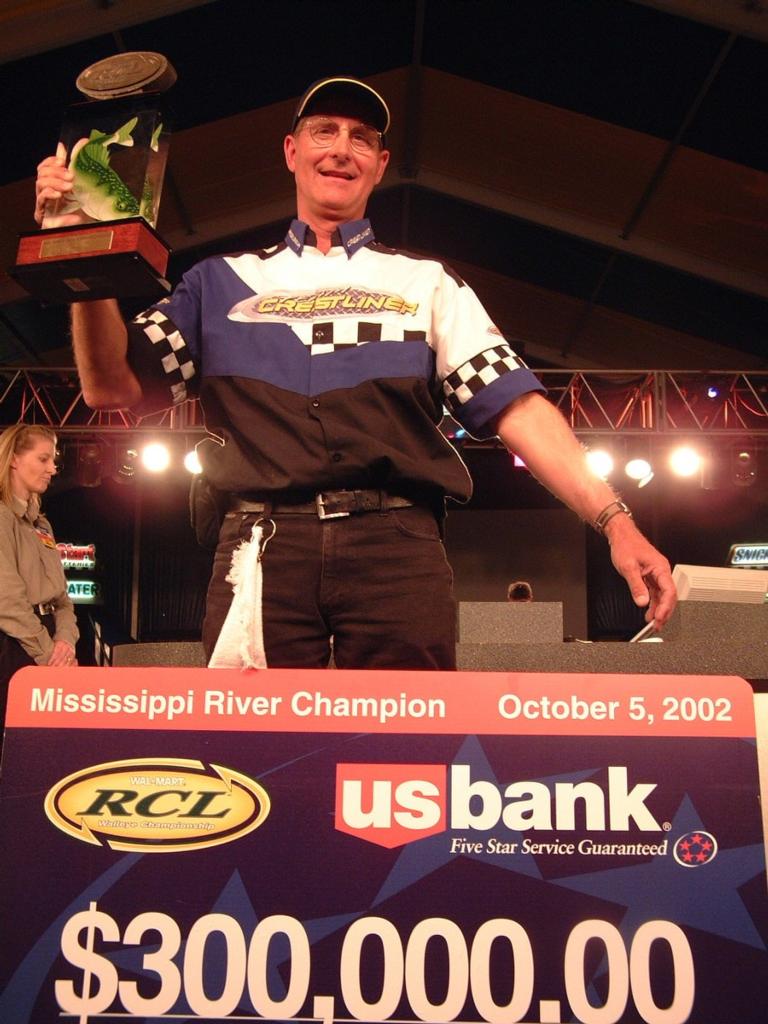Practice, precise presentations keys to success for Samson

RCL Championship methods revealed
Putting in time to thoroughly learn a body of water prior to fishing it is commonplace for most of the top fishing pros on the Wal-Mart RCL Walleye Circuit. In the case of the 2002 RCL champion, Crestliner pro Bruce Samson of Minnetrista, Minn., he put in nearly a year of time preparing for his $300,000 payday.
Along with preparation, Samson used nearly flawless execution of live-bait presentations to reel in the heaviest bag of walleyes on the final day of competition.
“I had been preparing to fish the RCL Championship for nearly a year,” said Samson. “When I decided to fish the RCL qualifiers this past season, I started to look at this area of the Mississippi River and made sure that I put in plenty of time to learn the water. I feel this was one of the keys to my success.”
While many anglers pre-fish or practice a few days prior to fishing a tournament, even the most prestigious walleye fishing tournament in the country, Samson took his practice further. He took the time to study the river and learn as many of the nuances about fish location and bottom contours as he could. After he assimilated all of this information, he decided where to fish. During this time period, he also decided what presentations would work best during the tournament.
“I ended up using a Roach rig and minnows to take the majority of my fish during the tournament,” said Samson. “A Roach rig is a live bait rig. I used fairly large minnows during practice the last few days before the tournament. Big minnows are what the walleyes wanted to eat.
“However, on the final day of the tournament, the walleyes wanted smaller minnows,” he said. “Four out of five fish I caught were caught using smaller minnows.”
Samson used a vertical presentation to precisely work his minnows in the 3- to 11-foot depths in various locations including Miley’s and Buffalo sloughs. Samson would use his Minn Kota trolling motor to slowly work his bait upstream, moving horizontally to thoroughly work a piece of structure. The vertical presentation was key to keeping contact with the walleyes. By moving the boat horizontally, it allowed Samson to position himself for better hooksets, and it allowed him to reach fish that were under his boat when a standard straight-line movement would eliminate his access to those fish.
Second place finisher, Lund pro Mike Gofron of Antioch, Ill., also used a live-bait approach. Gofron showed extreme patience and exceptional skill while fishing in a crowd.
“The area that I had the most confidence in was Buffalo Slough,” said Gofron. “It was crowded on the first day and even busier on the second day. I knew if I made it to the first cut I would have a good chance of fishing the area with a lot less company.”
Gofron has a reputation in the pro walleye-fishing world as a tough angler to beat when the bite is tough. With estimates of 40 to 75 boats converging on the area Gofron was fishing, it is amazing that he could successfully work his three-way rigs a rod’s length from fellow competitors.
Gofron also used a vertical fishing presentation, slowly working a small spot near a breakline on the east side of Buffalo Slough. Minnows were his bait of choice.
The third place finisher, Crestliner pro Rick Franklin of Louisburg, Kan., stayed away from the pack throughout the tournament.
“I decided to fish a cut near the nuclear plant,” said Franklin. “This was a real important area to me throughout the tournament. I also had a couple of other areas to fish when the bite turned off in that area.”
Like the top two finishers, Franklin used live bait rigs to catch the majority of his fish. Franklin caught walleyes using minnows and crawlers. He also trolled crankbaits with some success.
The three top finishers fished Pool 3 the entire tournament. Some of the pre-tournament scuttlebutt placed the winner downriver in Pool 4 out of Lake Pepin. Although several of the top 12 finishers headed through the locks to Pool 4, the top three stayed within minutes of the launch site in Pool 3.
Two other productive methods used among top-12 finishers included handlining and trolling crankbaits.
The handliners had better success fishing away from the crowds in Buffalo Slough or heading down to Lake Pepin. Productive lures used by handliners were gold and black, gold and orange, silver and chartreuse, and firetiger floating Rapalas in sizes 7 and 9.
Successful trollers used a variety of lures including both standard and jointed Shad Raps and a variety of stick baits. Anglers who had success trolling in the community holes would keep their crankbaits nearly vertical under their boats, using a snap weight to keep the lure at a precise depth and to avoid tangling other lines.